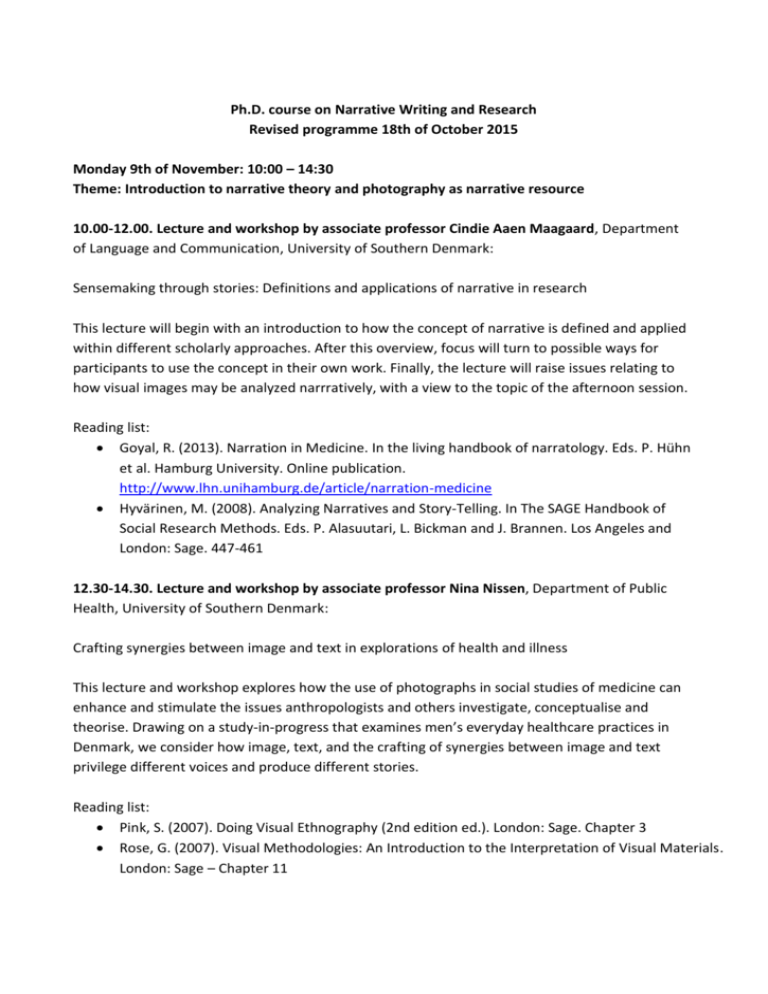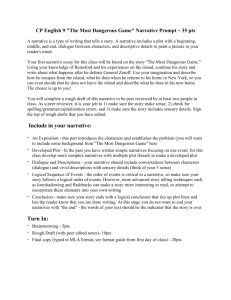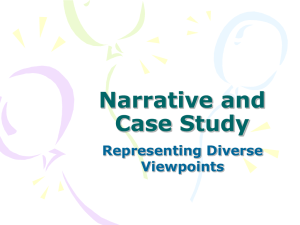Programme
advertisement

Ph.D. course on Narrative Writing and Research Revised programme 18th of October 2015 Monday 9th of November: 10:00 – 14:30 Theme: Introduction to narrative theory and photography as narrative resource 10.00-12.00. Lecture and workshop by associate professor Cindie Aaen Maagaard, Department of Language and Communication, University of Southern Denmark: Sensemaking through stories: Definitions and applications of narrative in research This lecture will begin with an introduction to how the concept of narrative is defined and applied within different scholarly approaches. After this overview, focus will turn to possible ways for participants to use the concept in their own work. Finally, the lecture will raise issues relating to how visual images may be analyzed narrratively, with a view to the topic of the afternoon session. Reading list: Goyal, R. (2013). Narration in Medicine. In the living handbook of narratology. Eds. P. Hühn et al. Hamburg University. Online publication. http://www.lhn.unihamburg.de/article/narration-medicine Hyvärinen, M. (2008). Analyzing Narratives and Story-Telling. In The SAGE Handbook of Social Research Methods. Eds. P. Alasuutari, L. Bickman and J. Brannen. Los Angeles and London: Sage. 447-461 12.30-14.30. Lecture and workshop by associate professor Nina Nissen, Department of Public Health, University of Southern Denmark: Crafting synergies between image and text in explorations of health and illness This lecture and workshop explores how the use of photographs in social studies of medicine can enhance and stimulate the issues anthropologists and others investigate, conceptualise and theorise. Drawing on a study-in-progress that examines men’s everyday healthcare practices in Denmark, we consider how image, text, and the crafting of synergies between image and text privilege different voices and produce different stories. Reading list: Pink, S. (2007). Doing Visual Ethnography (2nd edition ed.). London: Sage. Chapter 3 Rose, G. (2007). Visual Methodologies: An Introduction to the Interpretation of Visual Materials. London: Sage – Chapter 11 Optional reading (different examples of crafting synergies between images and text): Balmer, C., Griffiths, F., & Dunn, J. (2015). A ‘new normal’: Exploring the disruption of a poor prognostic cancer diagnosis using interviews and participant-produced photographs. Health, 19(5), 451-472 Elliott, D. (2015). Other images: Ebola and medical humanitarianism in Monrovia. Medicine Anthropology Theory, 2(2), 102-124 Radley, A., & Taylor, D. (2003). Images of Recovery: A Photo-Elicitation Study on the Hospital Ward. Qualitative Health Research, 13(1), 77-99 Tuesday 10th of November: 10:00 -14:00 Theme: Themes of illness in fiction 10.00-11.00. Lecture by professor Anne-Marie Mai, Department for the Study of Culture, University of Southern Denmark: Literature and medicine: a presentation of thoughts and ideas behind an anthology of literature aimed at the teaching of doctors and nurses The main theme of the anthology is the meeting between people in the health sector. There will be examples drawn from the works of Peter Seeberg, Djuna Barnes, Jens Blendstrup, Kirsten Thorup and Anders Bodelsen. The presentation will introduce recent American research on narrative medicine, which has had an influence on the creation of the anthology. Group discussions on utilizing fiction as an attempt to clarify the human experience in the interaction between patient, relatives, doctors and nurses. Reading list: Charon, Rita (2001). Narrative medicine – a model for empathy, reflection, profession and trust. JAMA (The Journal of the American Medical Association), vol. 286, no 15 Frank, Arthur W. (2007). Five Dramas of Illness. Perspectives in Biology and Medicine Vol. 50, No. 3. pp 379 – 394 11.15-14.00. Workshop by associate professor Lotte Huniche, Department of Publich Health, University of Southern Denmark: How to work narratively during the course of a Ph.D. project in relation to specific knowledge interests and aims – hands on Reading list: Jakobsen, Merete Demant (2015) Den alvorlige samtale. Sygdomsfortællingens veje og vildveje. Munksgaard; København Henriksen, Nina, Tine Tjørnhøj-Thomsen and Helle Ploug Hansen (2011). Illness, everyday life and narrative montage: the visual aesthetics of cancer in Sara Bro’s Diary. Health, 15(3) 277-297 Hurwitz, Brian, (2004). The temporal Construction of medical narratives. In Brian Hurwitz, Greenhaigh, Trisha, Skultans, Vieda (Eds). Narrative Research in Health and Illness. Blackwell Publishing; Oxford Monday 16th November: 10:00-14:00 Theme: Narratives on and of illness 10.00-11.45. Lecture and workshop by associate professor Karen Hvidtfeldt Madsen, Department for the Study of Culture, University of Southern Denmark: Autopatografies. Cancer narratives and cultural analysis The lecture will focus on cancer autopatographies and on the theory of narratives and autobiographies. Drawing on examples of both published and online material, different rhetorical, narrative and affective strategies will be discussed as well as which kind of knowledge these narratives hold, and how it can be decoded and used in research. Reading list: Aronson, J. K. (2000). Autopathography: the patient's tale. BMJ. Vol. 321. Issue 7276. s. 1599–1602. http://www.ncbi.nlm.nih.gov/pmc/articles/PMC1119270/ Hawkins, Anne Hunsaker (1999). Culture and medicine: Pathography: Patient narratives of illness. Western Journal of Medicine, 171 (2):127 Couser, G. T. (1997). Recovering Bodies. Illness, Disability, and Life Writing. Madison. The University of Wisconsin Press 12.15-14.00. Lecture by professor Helle Ploug Hansen, Research Unit of General Practice, Department of Public Health, University of Southern Denmark: Female Voices. How a poetic representation came into being Reading list: Glesne, Corrine (1997). That Rare Feeling: Re-presenting Research Through Poetic Transcription. Qualitative Inquiry, Volume 3 Number 2,pp. 202-221. Hansen, Helle Ploug (2012). Kvindestemmer. Liv og kræft, Nyt Nordisk Forlag, Arnold Busck, København Hansen, Helle Ploug (2012). At høre stemmer. Om tilblivelsen af bogen ”Kvindestemmer, køn og kræft”. Fokus, Nr. 3. Richardson, Laurel (1993). Poetics, Dramatics, and Transgressive Validity: The Case of the Skipped Line. The Sociological Quarterly, Vol. 34, No. 4, pp. 695. Shinebourne, Phina (2011). ‘I was Going Around with this Mist in Front of My Eyes’: Poetic Representation of the Experience of Addiction and Recovery. Int J Ment Health Addiction (2012) 10:174–184, DOI 10.1007/s11469-011-9313-x. Tuesday 17th November: 10:00-14:30 Theme: Journalism as narrative health research Lectures and workshops by Ph.D., senior researcher and journalist Jørgen Jeppesen, Research Department, The National Rehabilitation Center for Neuromuscular Diseases: From interview to story: journalistic transformation of transcript Jørgen Jeppesen will give and introduction to how he studies and practices narrative in the context of rehabilitation and palliative care. Since 2003, he has been a researcher and journalist at the National Rehabilitation Center for Neuromuscular Diseases (RehabiliteringsCenter for Muskelsvind). Prior to that, he worked as a journalist for 12 years in the Danish Neuromuscular Disorders Patient Association (Muskelsvindfonden). Participants will be engaged in discussions about journalistic storytelling in research and rehabilitation. Reading list: Jeppesen, J., Rahbek J., Gredal O., Hansen HP. (2015). How narrative journalistic stories can communicate the individual´s challenges of daily living with Amyotrophic Lateral Sclerosis. The Patient, 8, 41-49. [Including: Appendix A. Examples of transformation of interview data into dialogue, scene, and digression in a narrative journalistic story] Choose texts from the `Suggestions for further reading´ list at the end of this document Monday 23rd November 10:00-14.30 Theme: Storytelling Lecture and workshop by professor Nina Lykke, Gender Studies, Linköping University: Shifting the boundaries between academic and creative writing With a point of departure in reflections on the relationship between epistemologies, methodologies and writing strategies, the lecture will challenge traditional understandings of academic and creative writing as genres which are necessarily to be kept distinct and separate. Taking examples from the field of intersectional gender studies as well as from critical patienthood studies, the lecture will discuss how transgression of boundaries between genres can work as productive research tools or as sociologist Laurel Richardson phrased it: Writing as a method of enquiry. The lecture will be followed by a writing workshop, which will give participants the opportunity to reflect on different genres of writing, based on hands-on examples produced in class. Reading list: Lykke, Nina (2014) (ed.) Writing Academic Texts Differently. Routledge, New York. Chapter 2 and 9. Lykke, Nina (2010). Feminist Studies. Routledge, New York. Chapter 10-11. Richardson, Laurel (2000). Writing as a method of inquiry. Norman K. Denzin and Yvonne S. Lincoln. Eds. Handbook of Qualitative Research. London. Sage. 2nd ed: 923-948. Take away points and brief evaluation by course director Lotte Huniche Suggestions for further reading: Andrews, Molly, Squire, Corinne, Tamboukou, Maria (2008). Doing Narrative Research. Sage, Los Angeles Brody, Howard (2003), Stories of Sickness, Oxford University Press, Oxford Broyard, Anatole (1992), Intoxicated by my Illness. And Other Writings on Life and Death, Fawcett Columbine, New York Charon, Rita (2008), Narrative Medicine. Honoring the Stories of Illness, Oxford University Press, Oxford Couser, G. T. (1997). Recovering Bodies. Illness, Disability, and Life Writing. Madison. The University of Wisconsin Press. Csordas TJ. ed (1994): Embodiment and Experience. Cambridge University Press. Frank, Arthur W. Frank (1995), The Wounded Storyteller. Body, Illness and Ethics, The University of Chicago Press, Chicago and London. Gergen, Kenneth J. (2009), Relational Being. Beyond Self and Community, Oxford University Press Gergen; Kenneth J., Mary M. Gergen (1988), ’Narrative and the self as relationship’ in Advances in Experimental Social Psychology, ed. L Berkowitz pp. 17-56, New York Academic Press Gergen, Kenneth J. and Mary M. Gergen (2011). ‘Narrative tensions. perilous and productive’, Narrative Inquiry 21:2, John Benjamins Publishing Company. Hem, E. (2001). ”Med pasientens egen penn. Autopatografien som litterær sjanger”. Tidsskrift for den Norske Legeforening.Volume 121. Issue 9, s. 1136-7. http://www.tidsskriftet.no/?seks_id=304651 Jakobsen, Merete Demant (1999), Shamanism. Traditional and Contemporary Approaches to the Mastery of Spirits and Healing, Berghahn Books, Oxford Johannesen, Helle (2006), ’Introduction’ in Multiple Medical Realities, Patients and Healers in Biomedical, Alternative and Traditional Medicine, eds Helle Johannesen and Lazar Imre, Berghahn Books, Oxford Kinsella, Elisabeth A. (2006), ’Constructions of self,: ehtical overtones in surprising locations’ in Frances Rapport and Paul Wainwright eds, The Self in Health and Illness. Patients, Professionals and Narrative Identity, Radcliffe Publishing, Oxford, Seattle Kirmayer, Laurence (2000), ’Broken Narratives: Clinical Encounters and the Poetics of Illness Experience’, eds. Mattingly C. And L. Garro, Narrative and the Cultural Construction of Illness and Healing, University of California Press, Berkeley Kleinman, Arthur (1980), Patients and Healers in the Context of Culture, University of California Press, Berkley Kleinmann, Arthur (1988), The Illness Narratives. Suffering, healing & the Human Condition, Basic Books, USA Mattingly, Cheryl (1998 (2005)), Healing Dramas and Clinical Plots. The Narrative Structure of Experience, Cambridge University Press Mattingly, Cheryl (2005), ’Den narrative udvikling i nyere medicinsk antropologi’, i Narrativer, Tidsskrift for Forskning i Sygdom og Samfund, Foreningen Medicinsk Antropologisk Forum, Aarhus universitet Moerman, D. (2002), Meaning, medicine and the ’placebo effect’, Cambridge University Press, Massachusetts Rosenthal, Ann M. Ostenfeld (2012), ’Energy healing and the placebo effect. An anthropological perspective on the placebo effect, Anthropology & Medicine, volume 19, issue 3 Tolstoy, Leo (1960/1886), The Death Of Ivan Ilyich, Penguin Classics, England







